When I think about daisies, I think of my childhood. It’s the type of flower that you think about picking and putting in your hair, or offering to a friend nearby. The flowers are whimsical and the colours are so varied. Australia has its own native type of daisy – the ever lovely Brachyscome.
In our how to grow and care guide, we’ll look at introducing the Brachyscome and some of the popular species that you find in Australia. Let's go through its propagation, care, and what pests and diseases to look out for.
More...
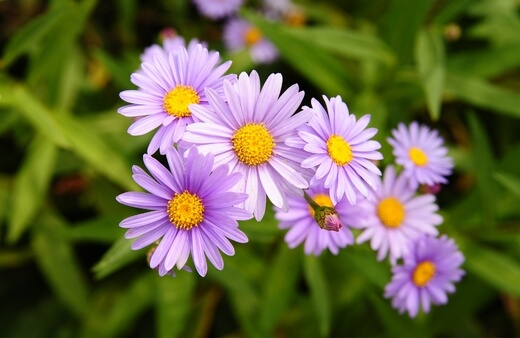
Family: | Asteraceae |
|---|---|
Genus: | Brachyscome |
Common Names: | Swan River Daisy, Rocky Daisy |
Location: | Indoor and outdoor |
Type: | Groundcover |
Growth: | Up to 45 cm tall and 50 cm wide |
Sun requirements: | Full sun to part shade |
Foliage Colour: | Grey green |
Flower Colour: | Varies depending on the species |
Flowering: | Spring and summer |
Fruit: | None |
Maintenance level: | Low |
Poisonous for pets: | No |
Introducing Brachyscome

The genus of Brachyscome is made up of 65 species and is native to Australia. You would more likely know this plant by its common names – these include Swan River daisy, cut leaved daisy, yellow tongue daisy, and rocky daisy.
Brachyscome has greyish green leaves, looks like a cross between a herb and a shrub, and it flowers during the summer and spring. The flowers have a lovely fragrance and look like daisies, hence the reference to daisies in its more common names.
The flowers are a whole range of colours, depending on the species, but are commonly white, yellow, pink, blue or purple.
Brachyscome Plant Features
Brachyscome is a great groundcover as it offers good spread and produces plenty of flowers. Although the main flowering seasons are spring and summer, you will also see some flowering scattered throughout the year.
Size wise, the Brachyscome can reach a height of 45 cm and a spread of around 50 cm. The variety and the conditions that the plant is growing in determine the ultimate size.
If you’re looking for a low maintenance plant that doesn’t need a large amount of water, this is a good choice. They look good and can fill in patches of the garden beautifully. Brachyscome is equally at home growing in a pot or as a border plant. So versatile!
Most Common Brachyscome in Australia
The more common species of Brachyscome that are found in Australia include:
Brachyscome iberidifolia (Swan River Daisy)Swan River Daisies are incredibly popular in Australia and there are so many varieties available. Look out for Mini Yellow, Mauve Delight, California Pink, and Blue Zephyr. There is also Purple splendor and Blue star. The plant tends to spread out like a field. |  |
Brachyscome multifida (Cut leaved Daisy)Also known as Rocky Daisy and Hawkesbury Daisy, this species is native to the Eastern part of Australia. There are two main varieties, namely multifida and dilatata, and this refers to the different leaf shapes. The multifida has smaller and narrower leaves. There are lots of different cultivars – the popular ones being ‘break o day’ and ‘amethyst’. |  |
Brachyscome ciliaris (Variable Daisy)This species produces rose or white flowers and is found in every state of Australia. It is small and bushy. There are actually 3 varieties recognized - Brachyscome ciliaris var. ciliaris, Brachyscome ciliaris var. lanuginose and Brachyscome ciliaris var. subintegrifolia. |  Source: VicFlora |
Brachyscome chrysoglossa (Yellow Tongue Daisy)This species is commonly found in New South Wales and Victoria. It produces yellow flowers, hence the common name and favours a subtropical environment. |  Source: Wikipedia |
Brachyscome decipiens (Field Daisy)This species is small and produces white or light blue flowers. You will find it mostly in Victoria, New South Wales and Tasmania. It is known for having twisted leaves that are close to the ground. | 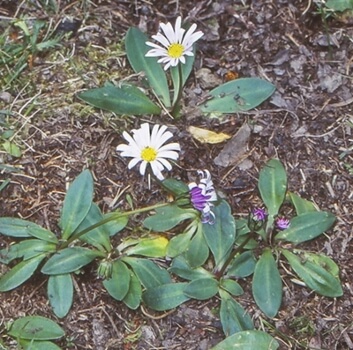 Source: apps.lucidcentral.org |
Brachyscome iberidifolia (Swan River Daisy)

These are incredibly popular in Australia and there are so many varieties available. Look out for Mini Yellow, Mauve Delight, California Pink, and Blue Zephyr. There is also Purple splendor and Blue star. The plant tends to spread out like a field.
Brachyscome multifida (Cut leaved Daisy)

Also known as Rocky Daisy and Hawkesbury Daisy, this species is native to the Eastern part of Australia. There are two main varieties, namely multifida and dilatata, and this refers to the different leaf shapes.
The multifida has smaller and narrower leaves. There are lots of different cultivars – the popular ones being ‘break o day’ and ‘amethyst’.
Brachyscome ciliaris (Variable Daisy)

Source: VicFlora
This species produces rose or white flowers and is found in every state of Australia. It is small and bushy. There are actually 3 varieties recognized - Brachyscome ciliaris var. ciliaris, Brachyscome ciliaris var. lanuginose and Brachyscome ciliaris var. subintegrifolia.


Get Your Free Guide:
Master Growing Australian Natives eBook
A Must Have Complete Guide for Every Australian Garden
Get Your Free Guide:
Master Growing Australian Natives eBook
A Must Have Complete Guide for Every Australian Garden
Brachyscome chrysoglossa (Yellow Tongue Daisy)

Source: Wikipedia
This species is commonly found in New South Wales and Victoria. It produces yellow flowers, hence the common name. It favours a subtropical environment.
Brachyscome decipiens (Field Daisy)

Source: apps.lucidcentral.org
This species is small and produces white or light blue flowers. You will find it mostly in Victoria, New South Wales and Tasmania. It is known for having twisted leaves that are close to the ground.
How to Grow Brachyscome
Brachyscome grows and can be cared for similar to other types of daisies. It can handle a whole variety of growing conditions – they just don’t like a hot or humid summer. The plant is hardy overall. They like coastal areas and even a light frost is no problem.
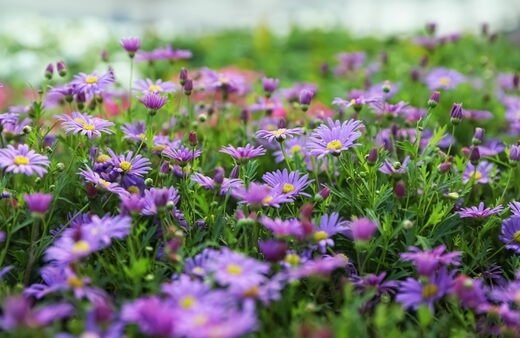
Brachyscome Propagation
Propagating Brachiscome from Cuttings
When taking your cutting, you are aiming for a shoot that has at least a node and two leaves that look healthy. Try and take the cutting before the plant has started flowering. Cut through the centre of the node with your scissors or gardening shears.
You can then put your cutting in water or in a potting mix without soil and keep it moist. The cuttings usually take about 2 weeks for roots to form. When it has at least 2 sets of leaves, you can then plant in a pot or straight into the garden.
How to Propagate Brachiscome from Seeds
You need to collect seeds from the centre of the flower and the best way to gather the seeds is to cut a flower from the stem when it’s starting to fade out. You can put the flower in a paper bag or even use a paper towel.
When the flower has dried out it will release the seed. If you’re storing the seeds for later use, you’ll need to keep them somewhere cold and dark and also make sure no moisture can get in.
When you’re ready to plant, use a seed tray with a layer of appropriate seed starting mixture and you’ll need to keep it moist. The seeds should take around 18 days to germinate.
Brachyscome Care Guide
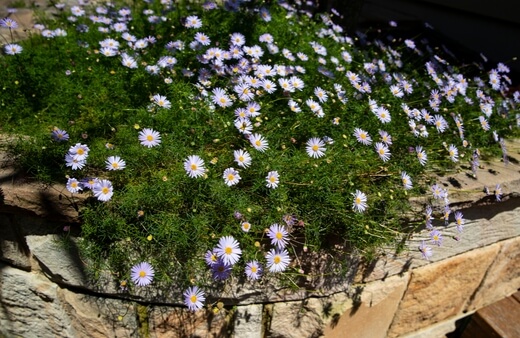
Sunlight Preference
Brachyscome absolutely adores the light. Much like all daisies, they do enjoy full sun but will also handle part shade just fine.
Watering Needs
Brachyscome is a drought tolerant plant so once it has been established, it won’t really need much water. If you are experiencing a season of dry weather, it’s still recommended to give your plant water for optimum health.
We suggest watering the plant from below, otherwise it might end up with powdery mildew. These plants do not appreciate being overwatered as their leaves are small.
Best Soil to Use
When Brachyscome grows naturally in the wild, it’s usually in shallow and sandy soil that is well-draining. Luckily for you, when you grow them at home you can offer the plant a whole range of soil types.
The plant can do light and sandy loam soil, or a heavy clay soil. As long as the soil drains well, all is well. A slightly acidic soil is recommended – aim for a pH of 5.5 to 8.
Pruning Brachyscome
After the flowers have appeared in summer, you can cut back your Brachyscome which maintains the shape of the plant but also helps it to produce more flowers. The flowers in general are not long lasting so when you do the deadheading of the plant, you’re actually keeping flowering going for longer.
Fertiliser
Your Brachyscome will thank you if you fertilise in spring each year. You can also mulch the roots which promotes an abundance of flowers. If you are growing your Brachyscome in a pot, it will need a constant helping of a low level fertiliser.
Brachyscome Plant Spacing
When it comes to spacing, you can aim for around 22 cm apart unless you are using it as a border plant, then around 15 cm apart is perfect.
Pests and Diseases that Affect Brachyscome
Botrytis
Botrytis starts off as a white growth on the plant and eventually becomes more grey. These fungal spores can be spread via wind or also transferred in water. If this disease attacks your plant, you’ll need to get rid of affected parts and prune where necessary.
Remember to sterilise your tools so you don’t spread the disease anywhere else. The right garden tools help you to get the job done. We’ve got honest and in-depth reviews about every kind of gardening tool and equipment.
Powdery mildew
Powdery mildew can be quite easy to spot. The patches will be white or light grey and look like powder. It often isn’t just confined to the leaf surface but also the underneath of the leaves, the stems and flowers too.
Over time these patches can spread to cover large parts of the plants, especially the new plant growth. There are some great organic fungicides that you can use for treatments – these include neem oil and potassium bicarbonate. Ideally you want to use these as early as possible when the disease starts.
Thrips
Thrips are a type of sucking insect that can transmit viruses which is the bigger concern more than the damage caused to the plant. If you’re looking for thrips, they are tiny and dark and you’ll probably need a magnifying glass to see them.
Pyrethrin is a natural pesticide you can use made from chrysanthemums. It needs about 2 applications, a few days apart.
Whitefly
Whiteflies are super tiny and have a triangle shape. They usually cluster together underneath the leaves. If you disrupt them they will scatter away. A soapy water spray is a great way to get rid of any small and soft bodied pests like whiteflies, aphids, thrips and mites.
Brachyscome Frequently Asked Questions
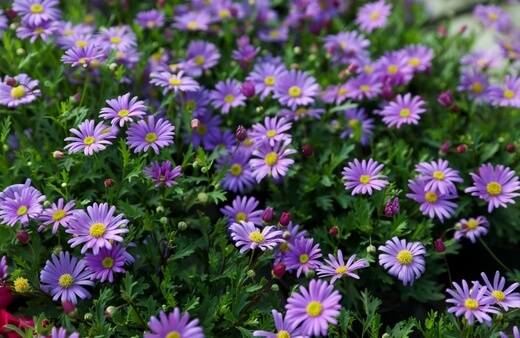
Can you eat the flowers of the Brachyscome?
The flowers of this plant are indeed edible, so get creative by putting them in a salad or any other dish that perhaps needs a bit of colour and decoration.
If edible flowers are your thing, check out our list of 96 best edible flowers to grow in Australia. Throughout history, humans have used edible flowers as herbal remedies, and for cooking.
Is Brachyscome considered an annual?
These plants are definitely considered long flowering and each plant can produce around 100 flowers. Just imagine the spectacular floral display!
Can you use Brachyscome as a trailing plant?
Brachyscome is considered a medium trailing plant and will definitely perform as you need it to on different structures in the garden.
Interested in learning more about other native Australian plants? Sign up for our newsletter and get all the info you need right at your green fingertips.
Wrapping Up Our Brachyscome How to Grow and Care Guide
Investing in a few different species of Brachyscome will bring joy to any Australian garden. The pretty leaves and lovely flowers fill up space in a garden, offering plenty of charm and delight.
They are super easy to care for and their hardiness means that even if you are a beginner gardener, you don’t need to be scared about killing them off. I’m certainly giving Brachyscome my green thumbs up.
Published on December 1, 2022 by Gary Clarke
Last Updated on January 19, 2025




